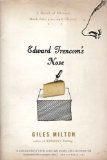Summary | Excerpt | Reviews | Beyond the Book | Read-Alikes | Genres & Themes | Author Bio

Critics' Opinion:
Readers' Opinion:
First Published:
Apr 2007, 320 pages
Paperback:
Jun 2008, 320 pages
 Book Reviewed by:
Book Reviewed by:
BookBrowse Review Team
Buy This Book
This article relates to Edward Trencom's Nose
Cheese can be made from the the milk of any mammal capable of being milked. Simply put, cheese making is the process of removing water from milk. The simplest method is to add an acid such as lemon juice or vinegar directly to the milk; an alternative method uses bacteria to create an acid in the milk; the bacteria also provides flavor and character to the finished product. The acid causes the milk protein to separate into curds (milk protein solids) and whey (liquid). The enzyme rennet (or a rennet substitute) is then added to coagulate the curds. Rennet is extracted from the membranes of calves' stomachs; rennet substitutes can be produced from various fungi and bacteria.
The resulting cheese depends on a number of factors including the balance of fat, protein and milk sugars in the milk which varies by animal (e.g. sheep milk is about 9% fat and 5% protein, whereas cow's milk has about 4% fat and 3% protein), the bacteria used, how the curds are processed, how long the cheese is kept before eating and how much water is left in the cheese (soft cheese contains over 45% water, hard/semi-hard cheeses contain 30-45% water, and dry hard cheeses such as Parmesan have less than 30% moisture content).
Since ancient times, inflated animal organs have proved to be useful storage devices. One theory is that the process of cheesemaking was discovered accidentally sometime between 8000 and 3000 BC when milk from one animal was stored in a container made from the stomach of another, and rennet in the stomach caused the milk to separate into curds and whey.
Egyptian tomb murals show cheesemaking dating to around 2000 BC. It's likely that these cheese were relatively sour and salty, similar to Greek feta cheese or cottage cheese. By Roman times, cheesemaking was a mature art and cheese an everyday food in most parts of Europe. However, it was unheard of in ancient oriental cultures, and in pre-Columbian America (even today, the majority of Asians and native Americans are lactose intolerant).*
Soft cheese such as Mozarella and Ricotta are relatively easy to make, withkits available online to get you started. Hard cheeses are more challenging.
Industrial processing of cheese began in Switzerland in 1815, but it wasn't until World War II that factory-made cheese using mass-produced rennet took over from traditional cheesemaking in America and Europe.
The dubious product known as processed cheese is made from regular cheese mixed with other unfermented dairy ingredients, emulsifiers, salt, coloring and, often, whey. The process was invented in Switzerland in 1911 but became ubiquitous in the USA after James L Kraft applied for an American patent in 1916.
The world is full of many wonderful cheeses, not least of which is Touloumotyri, which features strongly in Edward Trencom's Nose. It is a moist cheese made in Greece from sheep or goat's milk that can range from mild to piquant (to put it politely) and is traditionally stored in goatskin bags.
Cheese shops such as Trencom's are difficult to find these days, not only have most been lost to big chains, or have diversified into selling all sorts of items in addition to cheese, but the over-enthusiastic use of air conditioning and plastic wrappings has resulted in most cheese stores offering a feast for the eyes but rarely the nose. However, for a price, wonderful cheeses can be found in most localities and, if all else fails, by mail order.Infotoday offers a good selection of starting points and Wikipedia has a comprehensive list ofcheeses by origin. In addition, CowGirlCreamery not only offers illustrated information on how their cheese are made but also acomprehensive guide to artisan-made cheeses, with an emphasis on cheeses made in the USA.
*Although hard cheeses contain a fraction of the lactose of milk, it seems likely that cheese-making would have only developed into a full blown craft after the general population had become lactose tolerant. The normal mammalian condition is for the young of the species to lose the ability to digest milk after the end of the weaning period. Around 4000 BC, it is believed that a chromosomal mutation occurred in some human groups living in the Arabian Peninsula (and possibly separately in Northern Europe, specifically in what is now Sweden) that stopped the shutdown of lactase production around 4-5 years old, allowing these groups to digest milk throughout their lives. Lactose tolerance appears to have been a useful survival trait as, today, most adults of Western European and Middle-Eastern ancestry can digest milk.
Filed under Cultural Curiosities
![]() This "beyond the book article" relates to Edward Trencom's Nose. It originally ran in September 2007 and has been updated for the
June 2008 paperback edition.
Go to magazine.
This "beyond the book article" relates to Edward Trencom's Nose. It originally ran in September 2007 and has been updated for the
June 2008 paperback edition.
Go to magazine.





The House on Biscayne Bay
by Chanel Cleeton
As death stalks a gothic mansion in Miami, the lives of two women intertwine as the past and present collide.

The Flower Sisters
by Michelle Collins Anderson
From the new Fannie Flagg of the Ozarks, a richly-woven story of family, forgiveness, and reinvention.

The Funeral Cryer by Wenyan Lu
Debut novelist Wenyan Lu brings us this witty yet profound story about one woman's midlife reawakening in contemporary rural China.
Your guide toexceptional books
BookBrowse seeks out and recommends the best in contemporary fiction and nonfiction—books that not only engage and entertain but also deepen our understanding of ourselves and the world around us.